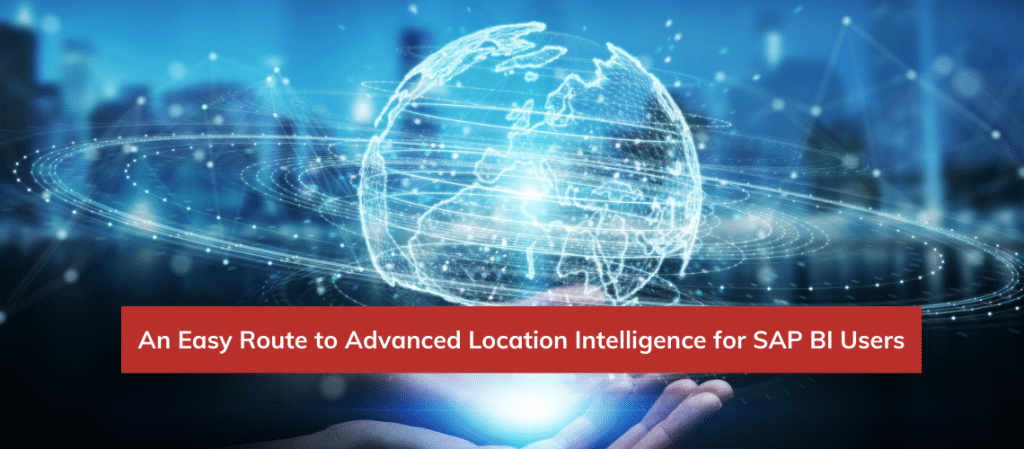
SAP Business Intelligence (BI) 2025, scheduled for release in Q4 of 2024, affirms SAP’s commitment to the BusinessObjects platform, including Web Intelligence (Webi), until at least 2029 for mainstream maintenance. That’s good news for on-premise or cloud-hosted customers who now have at least 6 years to plan their move to the cloud native future with SAP Analytics Cloud (SAC).
Perhaps you can wait to move to BI to the cloud, but can you afford to wait for advanced location intelligence (LI)? Location data and spatial analysis are key enablers top performing organizations use to understand markets and customers, conjure new products and services, and improve operations in every business function. “Organizations with a defined LI strategy, strong in-house capabilities, and who have realized advanced location-based use cases across multiple business areas and customer journeys reported 1.3 to 2.0 times improvement in customer experience, sales performance, and operational efficiency than organizations with limited capabilities satisfying simple use cases.” 1.
It’s Not The Same Old Location Intelligence
The way location intelligence is delivered, managed, and used today has changed. Drastically. Advances in technology – wireless, mobile devices, IoT, remote sensing, drones – have created a tsunami of spatial data that has extended the roles geospatial data, mapping, and spatial analysis play in the broader business.
While spatial data has exploded, the cloud has become the go-to place for heterogenous big data storage, processing, and analysis and LI vendors haven’t been just sitting around adding tools to make prettier maps. They’ve added support for big data technologies and platforms to store and manage spatial big data and developed algorithms, methods, and processes to mine and analyze massive amounts of heterogeneous unstructured spatio-temporal data rapidly. Machine learning and artificial intelligence extract geographic features from imagery, automate classification and segmentation, and help make predictions for decision making at all levels. Location intelligence today is nothing like the location intelligence of the past.
Falling Short, Falling Behind
Though the science, technology, and application of location intelligence have changed dramatically, their use within BI tools like Webi have not. In a world increasingly guided by location data and spatial analysis, sticking with the status quo spatial data and mapping capabilities of Webi to create map charts is no longer good enough. Users need access to the full breadth of spatial data available from both inside and outside the organization, not just the static boundary and point data that comes in the box. Advanced spatial analysis is also needed but lacking. While sales by country look better as a choropleth map than a bar chart, it offers little analytic insight. Even when overlaid with pie charts or graduated “bubbles” based on particular metrics, the map chart falls far short of the advanced spatial analysis needed and available today. With spatial data, analysis, and use cases rapidly advancing, staying where you are is falling behind.
With limited functionality for location intelligence in Webi, and no big plans for major enhancements, are you stuck with the status quo as LI plays an increasingly critical role in the business and in BI at every level? Can you afford to sit on the sidelines as location data and spatial analysis proliferates around you, out of reach? Do you want to forever depend on your operational LI team to find, create, manage, or provision the spatial data and maps you need for your dashboards and reports? Can your stakeholders afford to wait, or will they turn elsewhere? The stakes are high. Bad decisions are too costly. The status quo is not an option.
The Road to Advanced Location Intelligence
So you need to catch up. Move ahead. You can’t wait but don’t know how to get there. There’s an old saying from Maine – “You can’t get there from here” – used by locals when asked for directions to somewhere that can’t be reached without extensive, complicated directions; traversing miles of woods, boulders, and other obstacles; or taking multiple modes of transportation.
SAP is investing little to extend the geo-capabilities of its on-premise or cloud hosted BusinessObjects tools like Webi. That path is blocked by SAP’s “cloud first” approach, and the path forward for more location intelligence features in Webi is dim.
How about taking another route through SAP Analytic Cloud (SAC)? Well, there’s another obstacle or two on this path as well. Apart from the fact that many customers have thousands of Webi reports and dashboards and replicating them in another analytics tool could take years, even SAC gets relatively little geospatial investment and for good reason: it is hard to do. Better to leverage a location intelligence platform and deliver some capabilities out of the box rather than try to build a complete set of capabilities from an unknown technical domain outside your core business. This has been SAP’s location strategy for years, using Esri and others to deliver basic spatial data, mapping, and analysis in SAP BusinessObjects tools, including Webi, with some limited capabilities to extend them through APIs and spatial data import tools. That strategy continues today with SAC, and though it has many new spatial features its on-premise predecessors lacked, it does not, and never will, by design, be a complete location intelligence solution.
Finding The Right Path
If your destination is modern location intelligence and you stick with what you have to get there, then “you can’t get there from here” is not just a saying but a reality. You need to leverage a location intelligence platform to do the heavy lifting of data creation and management, rich map visualizations, and advanced spatial analysis and simply bring the results to your BI tool for use as-is or for blending with other non-spatial data for visualization and analysis in reports and dashboards.
Now that you’re on the right path, what location intelligence platform should you use? A simple google search on the topic will reveal hundreds of options from every corner of the location intelligence ecosystem. Content providers, those who create general purpose spatial data or tabular data associated with geographic features, have their “platform”. They offer ready sources of curated street data, boundary data, point data, and imagery with associated demographic, business, or other attributes for use in visualizations and spatial analysis. Some focus on just visualization, some mainly on spatial analysis. Some focus on certain industries, business functions like marketing or sales, applications like geomarketing, or cater to specific groups like end-users or developers. Which platform should you use?
For BI teams unfamiliar with location intelligence beyond what they see in Webi choosing can be a challenge. It is tempting to jump on the first bus that solves your immediate problem, only to find out that other problems are not on the bus route or require a different and faster mode of transport. Using multiple modes of transport for location intelligence introduces the delays, re-routes, and frustrations you encounter in your personal travel. It creates silos of data, maps, and analysis that conflict with each other, have different integration paths, and are hard to reuse and share. What’s needed is a platform that cuts across industries, business functions, applications, user groups, and problem domains to promote location intelligence as an enterprise versus a local asset.
Map Intelligence, Esri, and SAP: An Easy Route to Today’s Location Intelligence
Attain Insight Map Intelligence has supported multiple location intelligence platforms in the past, but today focuses on the Esri location intelligence platform as the best solution for customers of all sizes and needs. We’ve seen too many customers stuck in a platform cul-de-sac. It is a time-tested, modern, accessible, content and feature-rich platform suitable for those just beginning their journey or those who have too many platform vehicles and are tired of paying for and maintaining them all. It becomes the center of gravity for your location intelligence strategy, technology, and solutions with an open architecture that embraces specialized content, visualization, or analysis from other sources, bringing them under one managed and governable roof.
Attain Insight Map Intelligence uses Esri’s location services platform to bring the breadth and depth of today’s location intelligence to SAP Webi users. It works within familiar workflows of both the Esri and Webi teams and requires little training. It is built for the enterprise. It is scalable and uses and extends the Esri security model for role-based access to enterprise spatial assets. Best of all, it requires no custom development. It is an out-of-the-box packaged solution you configure to your needs without coding. The journey is short: it can be implemented in days and the path is easy to follow with no obstacles. It leverages your existing investments in Esri and Webi without introducing disruptive new location technology you need manage and maintain. And best of all, it is available today.
With Map Intelligence you’ll stop wasting time in chaotic processes to access and use the wealth of spatial data created by your internal Esri team as well as doing repetitive tasks that are easy to automate. You can stop using external, general purpose, static, old spatial data and start using internal authoritative real time spatial data created by and for your organization and specific to your needs. You can stop missing deadlines from lack of visibility into their work or recreating spatial data, maps, and analysis already available. Most importantly, your stakeholders can stop putting off decisions while they wait for critical location data and analysis.
Map Intelligence brings the Esri and SAP BI platforms together giving users the best of both worlds. Find out how you can get the best of modern location intelligence today by visiting attaininsight.com/map-intelligence-for-sap-business-objects. The status quo is not an option.
Footnote:
- “Unlocking Value with Location Intelligence”, Boston Consulting Group, 2021. Global BCG Survey on Location Intelligence for Enterprises (n=520), Oct 2020; BCG analysis.
